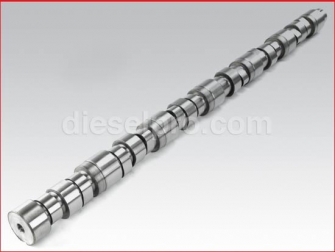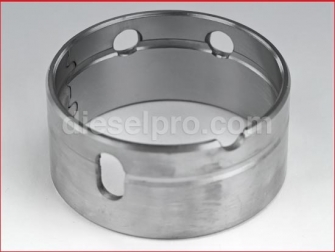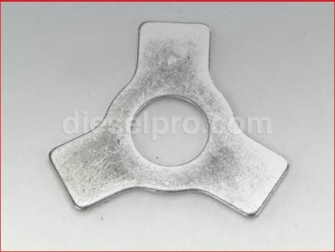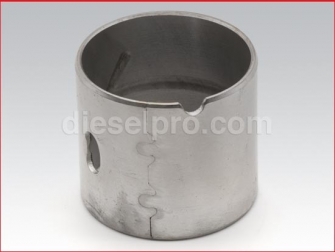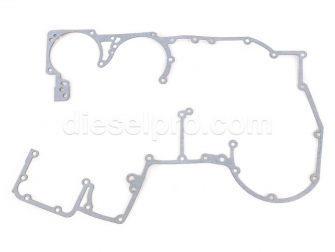Cummins QSK 19 Engine Parts for Australia - Camshaft Section
 Loading...
Loading... Cummins QSK19 Engine Parts – Camshaft Section
The camshaft is one of the most vital components of the Cummins QSK19 engine. Responsible for controlling valve timing and injection actuation, the camshaft synchronizes the fuel-air cycle with piston movement to ensure the engine delivers maximum performance, fuel efficiency, and reliability. In high-load environments—such as marine propulsion, mining haul trucks, and industrial generators—camshaft integrity is essential for engine health.
At Diesel Pro Power, we supply OEM-quality Cummins QSK19 camshafts and related components, including bushings, lock plates, support bearings, and sealing gaskets. Trusted by 40,000+ customers worldwide, we provide fast shipping, expert technical support, and the assurance of compatibility with both standard and CPL-specific engine configurations.
The Role of the Camshaft in the Cummins QSK19 Engine
The camshaft in a QSK19 diesel engine performs multiple functions:
-
Opens and closes intake and exhaust valves in precise timing
-
Activates injectors in mechanical or hybrid systems (depending on configuration)
-
Drives timing gears and auxiliary components such as fuel pumps
Proper camshaft timing is critical to maintain combustion efficiency, minimize emissions, and avoid engine damage. Due to the QSK19’s long inline-6 block and high RPM range, camshaft durability and proper alignment are essential, especially in continuous-duty applications.
Camshafts for Cummins QSK19 Engines
Camshaft Options for the QSK19
We offer two primary camshaft variants for the QSK19, both built to OEM specifications with hardened lobes, precision journals, and CPL-specific timing profiles. These camshafts are fully compatible with K19, KTA19, and QSK19 engines, though CPL matching is essential for certain applications.
This version is compatible with a wide range of QSK19 and KTA19 configurations. Ideal for general-purpose overhauls, marine re-powering, or industrial generator rebuilds. Precision-machined lobes ensure accurate valve lift and injector actuation.
Key Features:
-
Heat-treated for long life
-
Ready to install with new bushings and timing gear
-
Balanced for smooth rotation and reduced vibration
Designed for engines using specific CPL numbers, including high-horsepower and emissions-compliant versions of the QSK19. Matching your CPL ensures timing and injection ramp profiles align with your ECU or mechanical control logic.
Compatible CPL Numbers (examples):
-
1253
-
1455
-
2356
-
3778
-
4150
When to choose this camshaft:
-
If rebuilding a QSK19 with electronic control module (ECM) mapping
-
When CPL data is provided and exact match is needed
-
For factory-specified marine and industrial Tier 2/Tier 3 compliance
Camshaft Wear and Failure Symptoms
Over time, camshafts wear due to friction, poor lubrication, or misalignment. Failure to identify early symptoms can lead to complete engine failure. Here are common signs of camshaft wear in QSK19 engines:
-
Loss of power or efficiency
-
Unusual engine noise (tapping or knocking)
-
Excessive smoke due to poor valve timing
-
Engine misfires or difficulty starting
-
Metal shavings in oil during sampling
-
Irregular injector operation in mechanical systems
Prompt replacement of the camshaft and associated hardware during an overhaul prevents further damage to the valve train and injectors.
Supporting Components for QSK19 Camshaft Installation
When replacing or servicing the camshaft, it's critical to also inspect and replace the supporting components that ensure proper alignment and sealing.
Camshaft Bushings (7 Per Engine)
These bushings support the camshaft journals throughout the length of the inline-6 block. On the QSK19, the camshaft rides in seven precisely machined bearing surfaces. Worn bushings can lead to:
-
Camshaft misalignment
-
Valve timing variation
-
Excessive rotational drag
-
Lobe scoring or journal damage
Installation Tips:
-
Always replace all seven bushings during a camshaft service
-
Use alignment tools for proper bushing positioning
-
Inspect oil feed passages to ensure lubrication
Camshaft Lock Plate
The lock plate secures the camshaft’s thrust position, preventing endplay that could affect gear engagement and timing accuracy. A worn or missing lock plate may result in:
-
Excessive axial movement
-
Timing gear wear
-
Camshaft displacement during operation
-
Vibrational noise near the timing housing
This small but essential part should be installed with locking compound and torqued to factory specifications.
Driver Support Bushing
This bushing supports the camshaft drive side, often interfacing with timing gear covers or accessory drives. A worn support bushing causes radial play and premature wear on the drive gear, leading to:
-
Noisy operation
-
Gear misalignment
-
Camshaft runout
-
Timing chain or gear damage
For QSK19 engines, especially those with front PTOs or accessory drives, replacing the support bushing ensures stable gear mesh and camshaft performance.
Gear Train Cover Gasket
While not part of the camshaft assembly itself, the gear train cover gasket must be replaced during most camshaft removals or timing work. This gasket seals the front timing housing and prevents:
-
Oil leaks at the front of the engine
-
Contaminant intrusion into timing components
-
Gear wear due to dust or debris
-
Premature seal failures
Always clean mating surfaces and apply sealant as required to ensure a leak-free install.
Best Practices for Servicing a QSK19 Camshaft
Servicing the camshaft on a QSK19 requires strict adherence to Cummins specifications, especially in marine and Tier-rated engines. Here’s a checklist to guide technicians during camshaft service:
-
Obtain CPL Number: Always reference the CPL to determine correct camshaft profile.
-
Inspect Camshaft Journals and Lobes: Look for signs of scoring, pitting, or discoloration.
-
Replace All Bushings: Never reuse camshaft bushings.
-
Check Endplay: Use a dial indicator to confirm camshaft axial movement is within spec.
-
Replace Lock Plate: Always install a new lock plate with proper torque.
-
Flush Lubrication System: Remove debris and metal from oil galleries before final assembly.
-
Recalibrate Valve Lash and Injector Timing: Follow Cummins service manual procedures after camshaft installation.
-
Run Initial Oil Pressure Test: Verify pressure build-up during first engine cranking phase.
Why Diesel Pro Power for QSK19 Camshaft Components?
-
OEM-Compatible Components: Our camshafts, bushings, and fasteners are manufactured to match original Cummins dimensions and metallurgy.
-
Same-Day Shipping: Most camshaft kits and accessories ship same day.
-
Expert Support: Need help matching to your CPL or engine variant? We’re here to assist.
-
Complete Solutions: Order a full camshaft service package—camshaft, bushings, lock plate, support bushing, and gear housing gasket—in one place.
-
Trusted Worldwide: With customers in over 180 countries, we’re the go-to source for marine and industrial diesel parts.
Additional Scenarios That Require Camshaft Replacement
-
Hydraulic Lock Event: If the engine has suffered a hydrolock or overspeed event, camshaft damage may not be visible externally but can include bent lobes or stress fractures.
-
Metal Debris in Oil: When bearing failure has occurred elsewhere in the engine, circulating metal can score camshaft journals.
-
Timing Failure or Gear Slippage: A misaligned camshaft can cause valves to contact pistons—replacing the camshaft becomes necessary.
-
High-Hour Preventive Overhaul: For QSK19 engines operating beyond 20,000–30,000 hours, camshaft replacement is recommended during major rebuilds.
Camshaft Timing and Synchronization
Accurate camshaft timing ensures optimal engine breathing, power output, and fuel economy. On the QSK19:
-
Valve events (intake/exhaust) are controlled directly by the camshaft via pushrods and rocker arms.
-
Injection timing (for mechanical injectors) is governed by cam lobes dedicated to injector actuation.
-
Emissions performance is highly dependent on cam profile precision, especially in Tier 2/3 applications.
Even minor camshaft wear can throw off timing and lead to increased fuel consumption, white smoke, or derated performance.
Camshaft Rebuild vs Replacement
When Rebuilding May Be Possible
-
Journals are in good condition
-
Lobes show only light surface wear
-
No signs of metal fatigue or cracking
-
Engine is not operating in continuous-duty or mission-critical service
When Replacement Is Strongly Recommended
-
Pitting, cracking, or flat spots on lobes
-
Journal scoring or metal transfer
-
Camshaft was involved in catastrophic engine failure
-
Engine is used in marine or mining settings with high load factors
Replacing the camshaft ensures that the engine will operate at full power and reliability for another lifecycle interval.



 Free US Calls: 1-888-433-4735
Free US Calls: 1-888-433-4735 International: 305-545-5588
International: 305-545-5588






